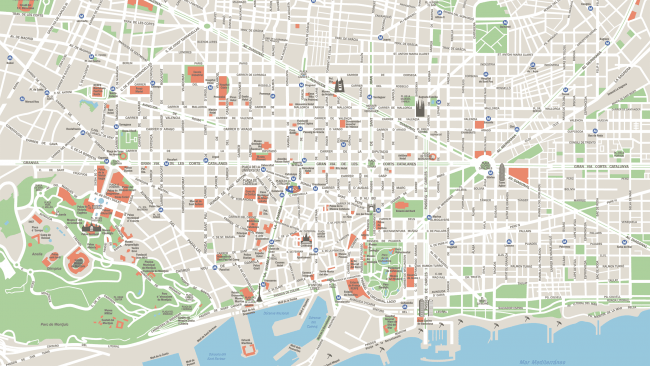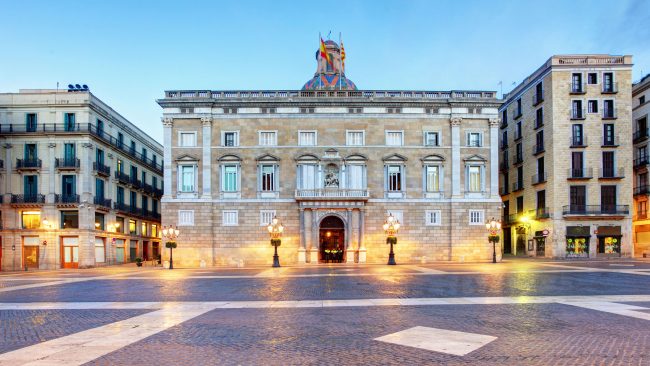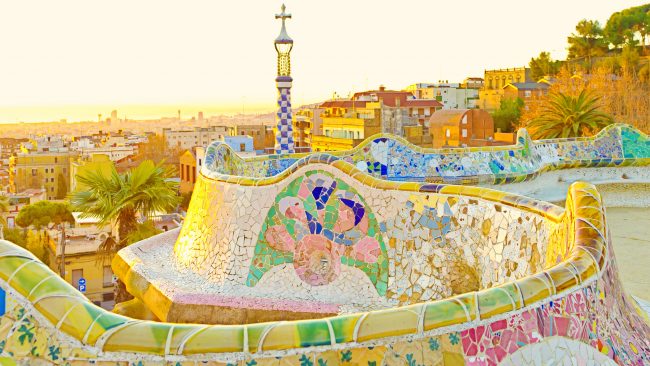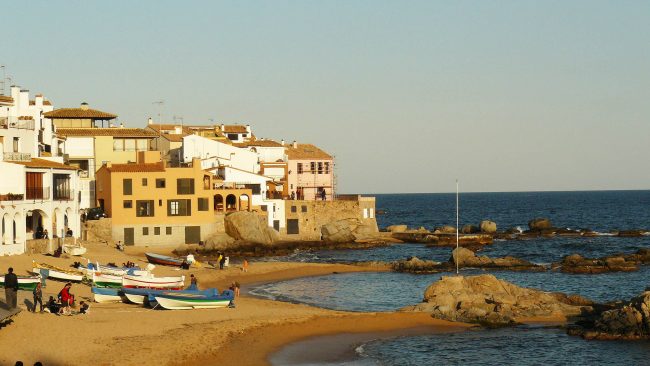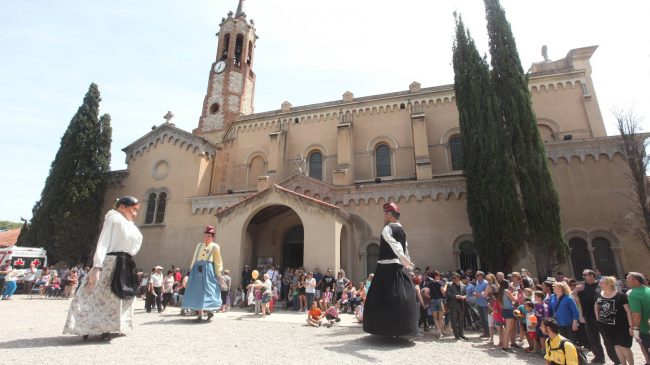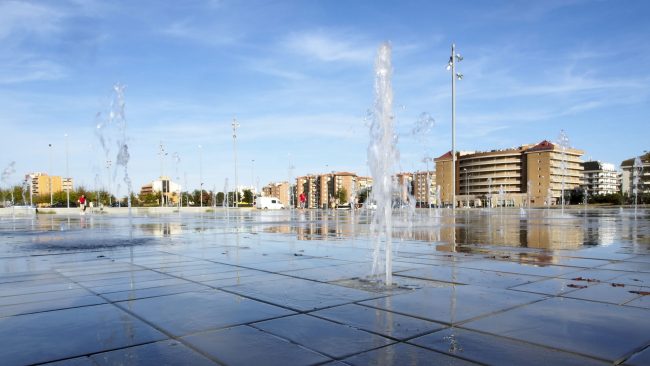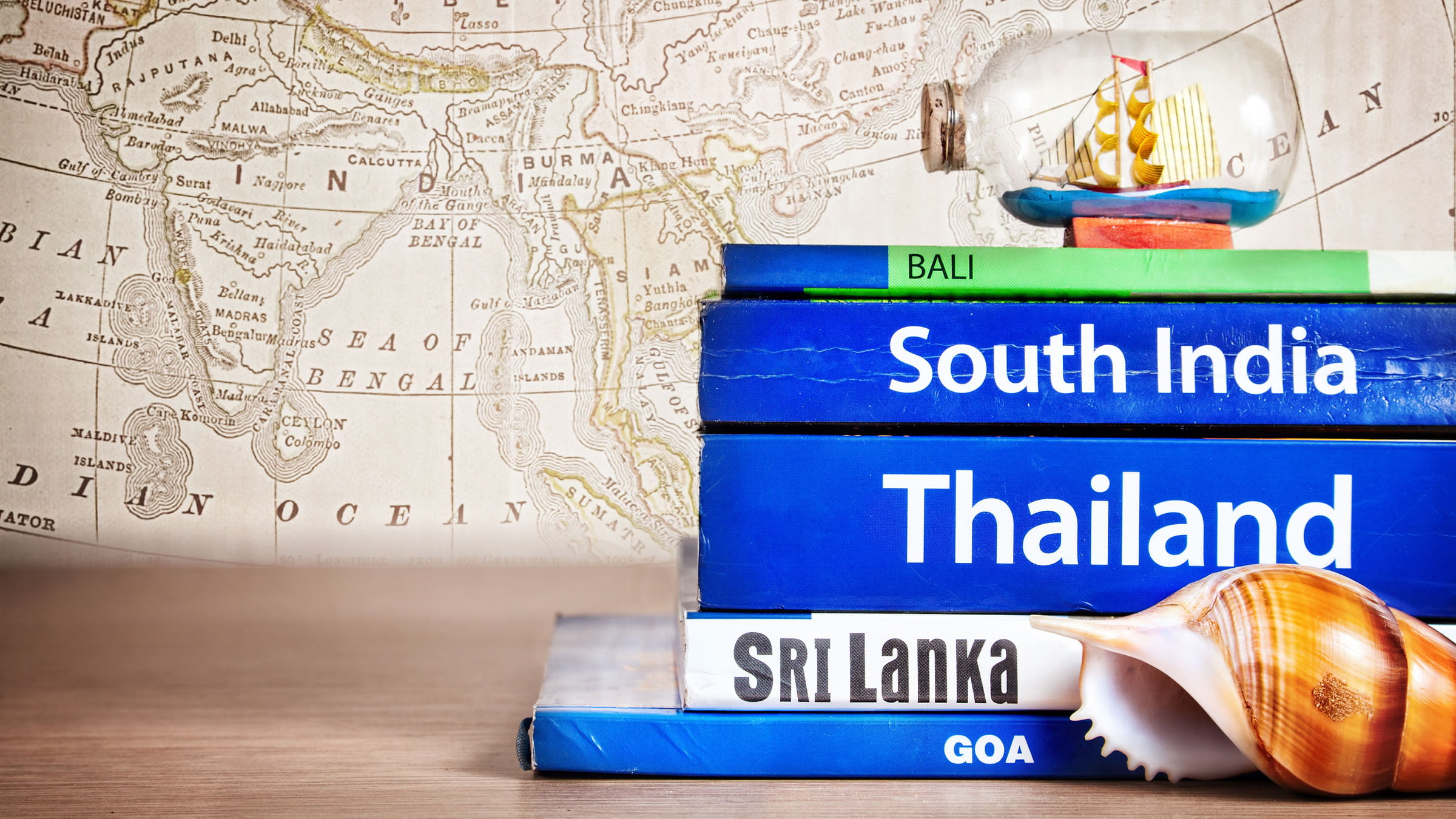Sightseeing in Barcelona is a possibility open to all types of tourists. The statistics make clear its position as one of the main tourist destinations in Spain, since it offers numerous options that range from urban to rural or gastronomic tourism. In this complete tourist guide in Spanish we show you everything you need for your next visit: where to stay, what to visit, what to see for free, what to do with children and much more.
Below you have an index with all the points that we are going to deal with in this article.
Article Index
- 1.
- 2.
- 3.
- 4.
- 5.
- 5.1.
- 5.2.
- 5.3.
- 5.4.
- 5.5.
- 5.6.
- 5.7.
- 5.8.
- 5.9.
- 6.
- 7.
- 7.1.
- 7.2.
- 7.3.
- 7.4.
- 7.5.
- 7.6.
- 7.7.
- 8.
- 9.
- 10.
General data
Barcelona is one of the most touristic cities in Spain, as well as one of the most populated after Madrid. One of its main advantages is that national and international tourists can enjoy several types of tourism at the same time: urban, historical, sun and beach, alternative tourism ...
According to Barcelona Tourism, official tourism website in Barcelona, the statistics grow year after year. In addition, the profile of the tourist is not only international, but also national and local tourists choose to visit the most emblematic sites of the city.
Here is a table that shows the percentage of tourists who stayed in hotels in Barcelona city according to their origin for the years 2014 and 2015:
| Provenance | 2014% | 2015% |
| United Kingdom | 8,6 | 8,7 |
| United States | 8,3 | 8,7 |
| France | 8,6 | 8,2 |
| Catalonia | 6,9 | 6,2 |
| Italy | 6,2 | 6,5 |
| Germany | 6,2 | 6,0 |
| Madrid | 3,9 | 4,2 |
| Japan | 2,2 | 2,0 |
| the Basque Country | 1,6 | 2,1 |
| Andalusia | 1,8 | 1,7 |
Barcelona has also increased its numbers in terms of Russian tourists, a sector that had fallen in recent decades, but which saw a further increase as of 2015, with approximately 50.000 visitors during that year alone.
You can travel to Barcelona cheaply or, on the contrary, as a VIP tourist, depending on the budget you have planned for your visit. It is a city in which the options are endless, so you can sleep in cheap hostels or eat something simple, fast and at a good price. In addition, there are numerous low cost flights that arrive at the Barcelona-El Prat Airport.
You should know that there is a tourist tax or tax on stays in tourist establishments that must be paid per person per night. This is its own tribute charged by the Government of Catalonia and ranges from € 0,5-2,5 per night, depending on the category of the hotel where we stay. This rate does not apply to children under 16 years of age.
All tourists are recommended to go to a tourist office to obtain information regarding the tourist attractions of Barcelona, public transport options, etc. There is a wide network of information points throughout the city.
Brief history
The history of Barcelona dates back to 4.000 years ago, when it was born from the union of various peoples, including the Iberians, Romans, Visigoths, Jews, Muslims and Christians. Perhaps the most prominent periods can be summarized in the following three periods:
- Medieval times: the County of Barcelona acquires preeminence over the rest. After the formation of the Crown of Aragon, it became one of the main political, economic, commercial, social and cultural centers of the Mediterranean.
- XIXth Century: the city grows at a demographic, economic and urban level after the crisis experienced during the late medieval era. The Ensanche plan and the expansion of the entire urban perimeter take place. In the social sphere, however, the class struggle between the proletariat and the bourgeoisie is accentuated, which gives rise to the birth of the modernist current in the artistic field.
- Twentieth Century: political unrest culminates in the Spanish Civil War. After the end of the Franco dictatorship, the city began a period of recovery with the arrival of democracy.
Starting in the 2010st century, Barcelona became a prosperous and internationally recognized city. However, after the autonomous government of Artur Mas in 2015, the rise of the independence movement of Catalonia took place, which currently continues in an extensive political debate. Since XNUMX, the mayor's office has been led by Ada Colau, in favor of a more social and corruption-free policy.
How to get
If you are traveling from another Catalan or national city, the best option to visit Barcelona is the train. Renfe offers a wide long and medium distance network through the Talgo, Euromed, R. Expres and Alaris trains, among others. There are special offers that can lead to great savings if you buy your tickets in advance. The main station for arrivals in this mode of transport is Barcelona Sants.
On the other hand, traveling by car from another Spanish city is one of the most common options among national tourists. It is located about 620 km from Madrid, 350 from Valencia and around 300 from Zaragoza. The trip can be easily organized with a GPS thanks to the Google Maps or Google Earth application. Lonely Planet or Repsol paper guides also offer very useful maps.
However, traveling by car can often be more expensive than if we do it by any other means of transport, due to the high number of tolls on the highway that goes there, especially if you leave from Valencia. To see the different highways and prices from various cities, we recommend clicking on this link.
Frequently, low cost airlines as Ryanair o Vueling They offer flights to Barcelona for very affordable prices (from € 30), which could be an alternative to the train or car if your budget is limited. Furthermore, the Barcelona-El Prat Airport is one of the most important in Spain, with numerous connections by metro, bus and taxi to the city center.
There is also the possibility of reaching by boat or bus, although they are the least requested options due to their long duration. However, the bus is the cheapest option to get there, although on the other hand it is the option that will take you more hours. On average, a trip from Madrid takes about 8 hours, while from Santander it can take you 10 hours or more.
City maps
Barcelona is a relatively large city. Therefore, if you do not know it, it is advisable to carry a good map with which you know at all times where you are and do not have the risk of getting lost.
In addition, today, we find numerous types of plans, each one adapted to the needs and tastes of each person. In a place like Barcelona, you can find them in almost any language.
The most recommended maps for tourists are those that indicate where the most important attractions are and provide a brief explanation of each one. It is also better if the public transport network is represented.
Where to go sightseeing
What to see and do is a part of our trip that depends on the duration of it. Therefore, our advice before traveling is to organize and plan which tourist sites you are going to see based on the average time that the visit to each of them usually lasts.
The extension of the metropolitan area of Barcelona makes it a city suitable for all kinds of tourism and for all types of public, from young people to retirees. It is also a very good option for alternative tourism, especially if you pass through the Gothic Quarter, one of the oldest areas of the city.
It is a tourist area where you can leisurely stroll through labyrinthine medieval-looking streets, while enjoying well-known points such as the Cathedral of Santa Eulàlia, Plaza Sant Jaume, Carrer del Bisbe, Plaza Real or the neighborhood. Jew.
If your trip is going to be only a weekend (2-3 days), the best thing would be to focus on the Ensanche district, which is the area where the main neighborhoods and points are located:
- Casa Mila
- Arc del Triomf (Arc de Triomphe)
- Ciutadella park
- Barcelona Zoo
In one day you can visit these points, leaving us the Sagrada Familia, which is a little further away, for the next.
The most important tourist places in Barcelona are concentrated in several points and are the result of combining several tourist options: from urban tourism to nightlife, passing through other options such as LGBT tourism. In summary, the most notable monuments and areas are:
Town hall
Also known by the nickname of House of the Ciutat, is located in the Plaza Sant Jaume. Open days are organized on February 12 (Santa Eulàlia), April 23 (Sant Jordi) and during Corpus Christi. It is worth visiting to enjoy its Gothic architecture.
Sagrada Familia
The Expiatory Temple of the Sagrada Familia is a Catholic basilica designed by the famous architect Antonio Gaudí. Although its construction began in 1882, it has not been completed today. It is considered Gaudí's main masterpiece and the greatest exponent of Catalan modernism.
Palace of the Generalitat
In tune with the characteristic Gothic-Renaissance style of the city, the Palace of the Generalitat of Catalonia is one of its most visited points. It is located in the Ciutat Vella district, specifically in the Plaza de Sant Jaume.
Avenue
It is one of the most central streets, where you will find innumerable street stalls where you can buy everything from food to souvernirs from the city. If you walk from the beginning to the end, you will reach the famous Columbus Monument, in the Plaza del Portal.
https://www.youtube.com/watch?v=cAsjulFPhys
Montjuïc
Montjuïc mountain is a must-see tourist spot, largely due to the many museums that are found there: Fundació Miró, Museu d'Arqueología, Museu Nacional d'Art de Catalunya (MNAC), etc.
In the area known as "Anilla Olímpica" is located the Estadi Lluís Companys and the Santiago Calatrava telecommunications tower.
Beach
If you travel in summer, you cannot leave without visiting the beaches of Barceloneta, Somorrostro, Sant Miquel, Sant Sebastià or Nova Icària, all of them highly popular. Sitges, for its part, is the ideal destination to do gay tourism.
The of the Barceloneta It is the first beach in Barcelona. It is a summer corner where you can enjoy many other activities apart from taking a bath: doing windsurf y Kite surfing It is within your reach if you are passionate about this type of sports.
Park Güell
Parc Güell is a public park located in the upper part of the city. It is the work of Gaudí commissioned by the businessman Eusebi Güell, hence its name.
It's considered World Heritage Site "Works by Antonio Gaudí", because it is a reflection of the artistic fullness of the Catalan architect.
Basilica of Santa Maria del Mar
Built between 1329 and 1383, it is located in the Ribera neighborhood. Currently, it is a Catholic church in the Catalan Gothic style whose fame has made it the protagonist of such well-known literary works as The cathedral of the seaby Ildefonso Falcones. It is also referenced in The game of the angel scored by Carlos Ruiz Zafón when we have the information.
Born and Raval neighborhoods
Barcelona also offers other possibilities if you don't want to move around the busiest areas. It is one of the most recommended cities for Alternative tourism, with numerous shops, bookstores, restaurants and special places to do different things. The Born or Raval neighborhoods are the most advisable to enjoy this type of establishment.
Where to stay
As we said above, Barcelona has an almost infinite hotel offer that has been consolidating since the beginning of the 1992 Olympic Games to the present day. Whatever your preferred type of accommodation, in Barcelona you will surely find it.
The best areas to sleep are in the Eixample, Gothic Quarter and Catalonia Square. The Paseo de Gracia (Sightseeing in Catalan) is also one of the best areas, although the prices you will find here will be somewhat higher because it is one of the most central points, with access to the main tourist spots.
On the other hand, the areas to avoid, especially at nightfall, are the Ramblas and the Raval. Although during daylight hours they are the most touristic spots in the city, the truth is that at night they are not the most recommended.
If you decide to stay in a hotel, the average price per night and person is around € 50 in a simple establishment without great luxuries. The most valued hotels are those that, as we said before, are located in the area closest to the center, in which case the average price could reach € 100.
For stays of more than 2-3 days, a good option to save on lunch and dinner could be to rent a tourist apartment. Although the cost per night may be somewhat higher, in the end it is an advantage for our pocket because we avoid having to eat out every day, which ends up making our trip cheaper.
What to see in the surroundings
The trips of 4, 5 or 6 days give to see many other places and not so well known corners of the city. The municipalities and cities around Barcelona are an excellent option to get to know Catalonia in greater depth, so here are some suggestions if you want to explore other Catalan areas:
Calella
This municipality located on the coast belongs to the Maresme region, 56 km from Barcelona. It is a destination very frequented by Germans, which is why it is popularly known as Calella of the Germans. The main points of interest are the lighthouse, turrets, the Pineda de Can Dalmau and the Manuel Puigvert promenade.
Cardona
Located in the Bages region, this town has a Romanesque-Gothic style castle that was built in 886 by Wifredo el Velloso. Other outstanding places are the Church of San Miguel, the collegiate church of San Vicente de Cardona, the Salt Mountain, the Market Square and the Botxí Tower, among others.
Girona
Girona is a city belonging to Catalonia that is located about 100 km from Barcelona, so it takes about 40 minutes by AVE and 1 hour and 30 minutes by car.
It is worth visiting its historic center or Old neighborhood, one of the most beautiful in Catalonia. It has monuments such as the Call (old Jewish quarter), the colorful Houses of Oñar and the Gothic-style Cathedral, considered the widest in the world.
Rupit i Pruit
It is the last town in the province of Barcelona, belonging to the Osona region. It is a small town of no more than 400 inhabitants where you can enjoy visiting various Romanesque churches, like the Church of San Juan de Fábregas or that of San Lorenzo Dosmunts.
The Santuario del Far and the entire urban nucleus, with its stone streets, are also key points.
Sabadell
It was the pioneer city in the Industrial Revolution of Catalonia and, currently, it is the fifth most populated municipality, with more than 200.000 inhabitants, according to INE data published in 2014.
You can visit different museums, such as the History of Sabadell, the Art Museum or the Dr. Miquel Crusafont Paleontological Institute. Also highlights its major festival, called Aplec of Health, in which families go on foot to the hermitage to eat, dance and carry out other group activities.
Santa Susana
Written Santa Susanna in Catalan, it belongs to the Maresme region, in the province of Barcelona. It is one of the charming towns in Catalonia, where you can visit traditional places of the Catalan coast.
Due to its location, it is a strategic point to start routes to the Costa Brava or the interior of Spain. The old chapel of Santa Susana or the Molino d'en Jordà (XNUMXth century) are the main points of interest.
Vic
This municipality is famous for its frequent fog in winter, a time during which temperatures as low as -10 ° C are reached. In summer, on the other hand, storms are common, which favors the presence of plant species such as oak.
It stands out, on the one hand, for having one of the most striking ensembles of medieval origin in Catalonia; on the other hand, its sausages, especially the salchichón de Vic, are famous inside and outside the country.
When to go
The city's Mediterranean climate gives rise to cool winters and rather hot summers. If you decide to travel in winterYou must bear in mind that the average temperature is around 6-7 ° C, so you should wear warm clothes, especially in the months of January and February.
A good option to go to Barcelona in winter is to do it at Christmas. You will find the city decorated with Christmas lights and Christmas trees in the main shops and, in addition, several markets are set up throughout the city, such as the Fira de Santa Llúcia, which is placed right in front of the entrance to the Cathedral.
You will find frequent torrential rains in the autumn and winter, especially during the months of September and October. Strong storms accompanied by lightning and thunder are common. However, the rainy city offers endless possibilities: from having a drink in a tea shop to numerous spas to relax.
July and August are the strong hot months, with temperatures of 37 ° C or more. In addition, the percentage of humidity is usually high as a consequence of its location by the sea. For this reason, we recommend that you look for hotels that have air conditioning or, at least, a fan if you are going to visit Barcelona in summer.
On the other hand, fans of the celebrations of eastern You will find a wide range of traditional activities if your stay coincides with the period from March 24 to 28. Examples of this are: the Procession of Silence in Badalona, the Andalusian Holy Week in l'Hospitalet or Good Friday, with the Sermon of the Seven Words in the Cathedral of Barcelona.
Getting around
The bus network is made up of 80 lines that give access to practically any corner of the city. They are fully adapted for people with reduced mobility and the hours are very functional: from 4:25 in the morning to 23:00. There is also a night bus service called Night Bus, with hours from 22:40 to 5:00 in the morning.
The city of Barcelona has one of the best public transport networks in Spain and Europe, with 8 metro lines whose frequency of passage during working hours is approximately every 3 minutes. In addition, there is a stop in all the central points of the city, making it the most comfortable way to quickly sightsee.
The lines are easily identifiable because each one is a different color. The price of a single ticket is € 2,15. However, for tourists it is advisable to buy a T-10 voucher for € 9,95, which can be much cheaper than traveling with single tickets, especially if the stay is going to be more than one day. There is also fertilizer Hello Barcelona for periods of up to 5 days.
If you prefer to opt for a more ecological form of tourism, moving by bike is perhaps the most recommended option. The city has perfectly adapted lanes to move from end to end, including the main parks. You can consult the main bicycle rental companies by clicking on this link.
La tourist card Barcelona Card It is ideal for stays of more than two days, as it saves money and time. It is aimed at people who are going to be between 3 and 5 days, and its main advantage is that it combines unlimited trips by public transport with entry to all monuments and museums without having to pay at the moment. For more information, visit the official website at this link.
Practical tips
As it is the second largest city in Spain, if you are going to travel to Barcelona we recommend that you follow a series of tips to avoid setbacks and make your trip a success, even if you decide to travel on a reduced budget:
- To avoid queuing, it is recommended to buy tickets online for the following monuments: Sagrada Familia, Casa Batlló, La Pedrera, Santa Pau Recinte Modernista and Fundación Joan Miró.
- Some museums offer free entry the first Sunday of every month from 15:00 p.m. to 20:00 p.m. Some examples are: Museum of History of Barcelona, Disseny Hub Barcelona, Maritime Museum of Barcelona, Museum of Decorative Arts, Botanical Garden and Museum of Natural Sciences.
- According to the opinion of most travelers, November is the best month to visit the city, specifically after the All Saints bridge and just before the end of the month bridge. It is the time when you will find fewer tourists.
- It is best to carry one tourist information guide and a map handy throughout the trip.
If you travel by train, the most common is that the destination is the Barcelona-Sants Station, where you will find most of the necessary establishments, including a Tourist Office, an official FC Barcelona store, the Hotel Sants and a luggage deposit, Very useful to move around the city without having to carry suitcases or other packages.
This article has been shared 65 times. We have spent many hours collecting this information. If you liked it, share it, please:




